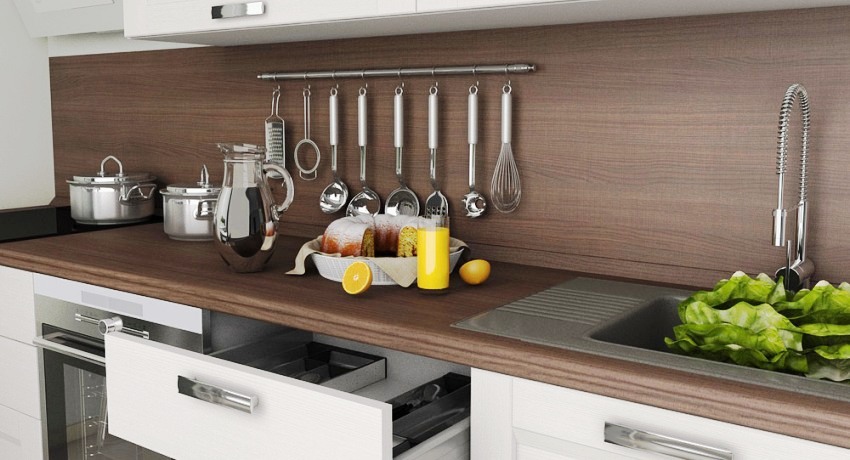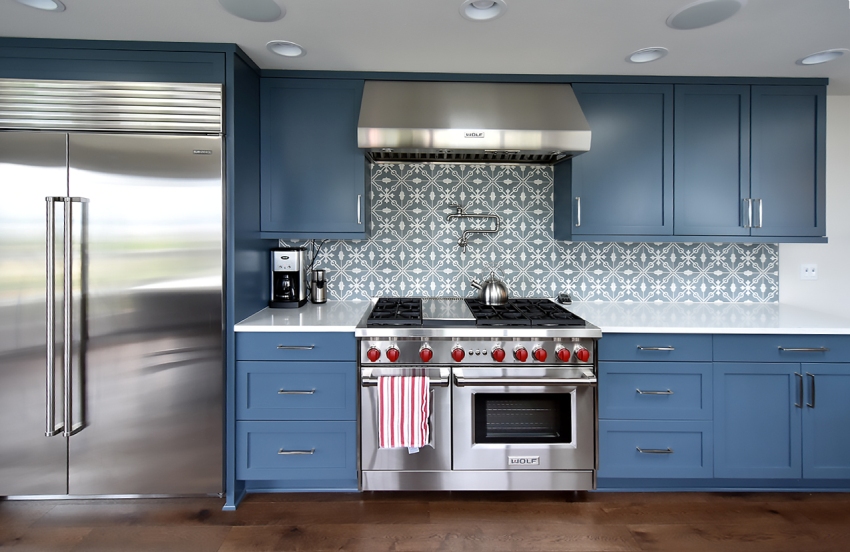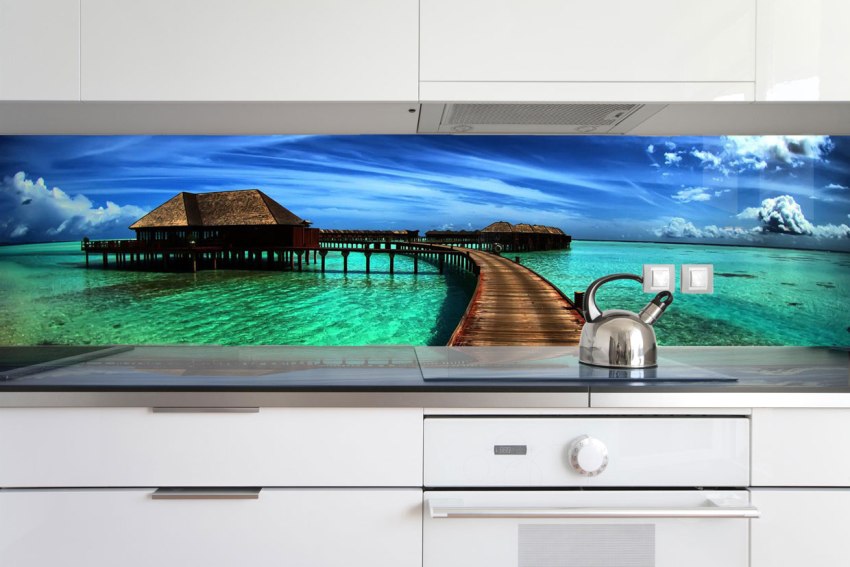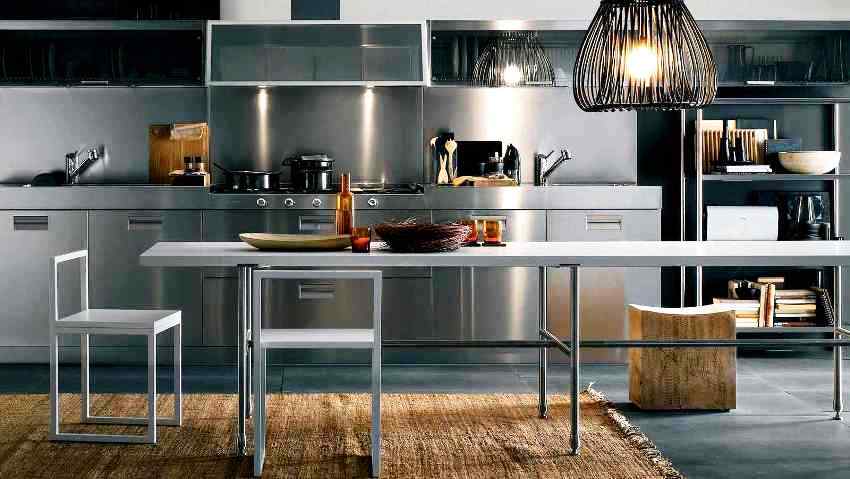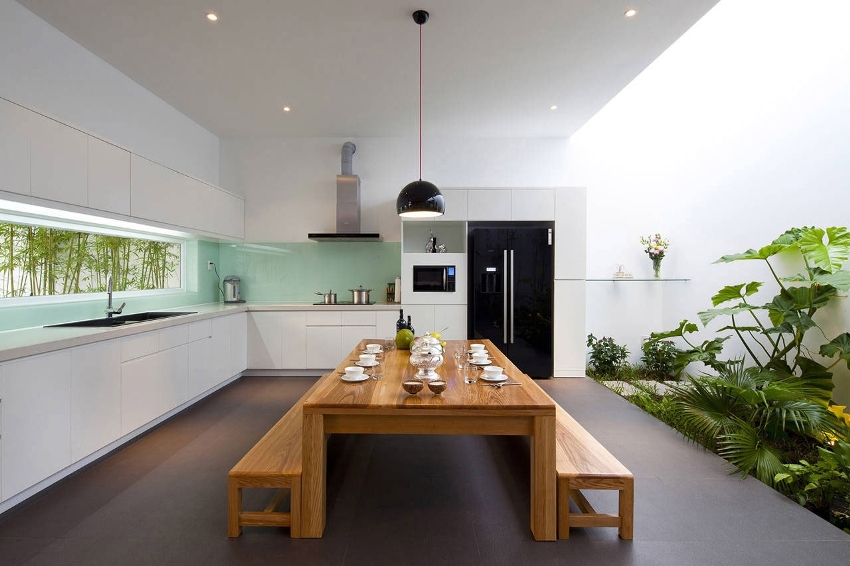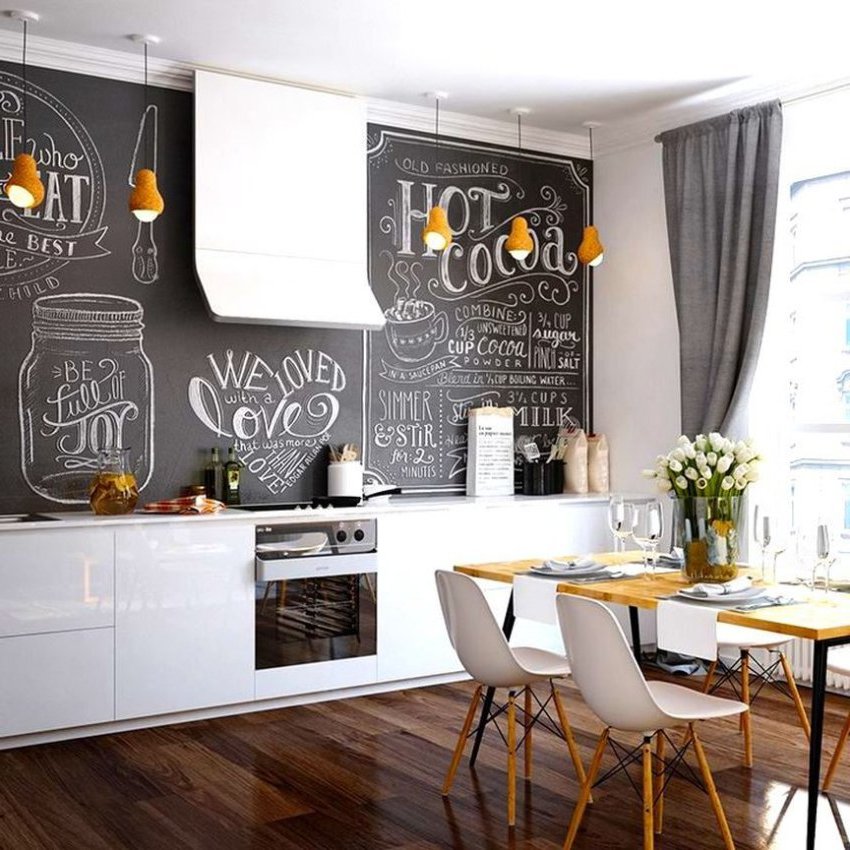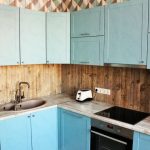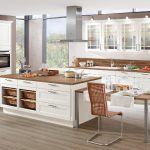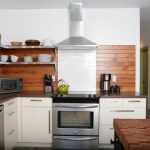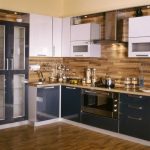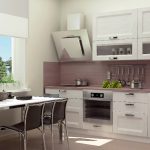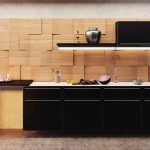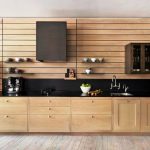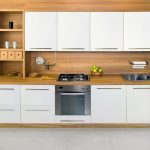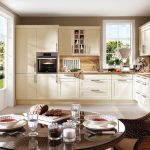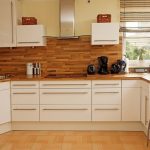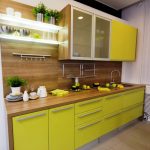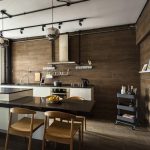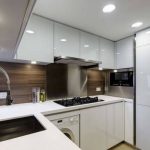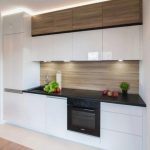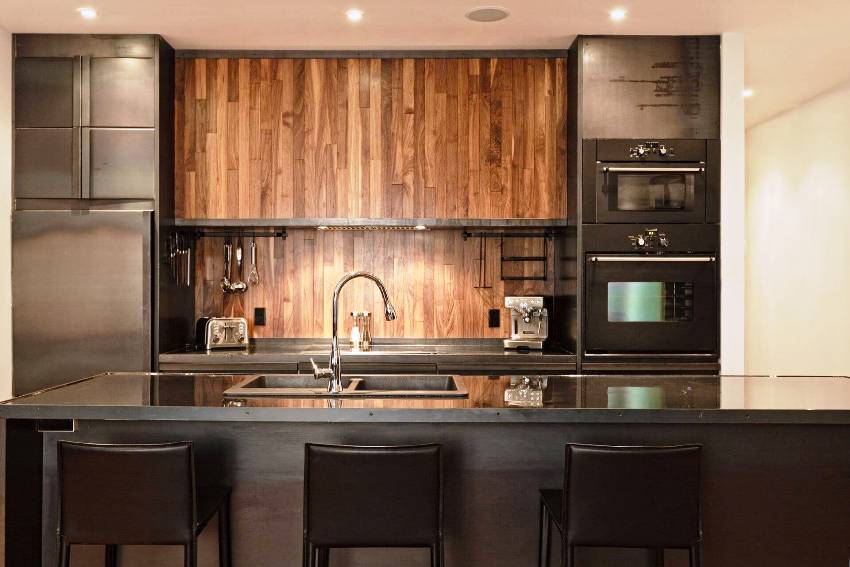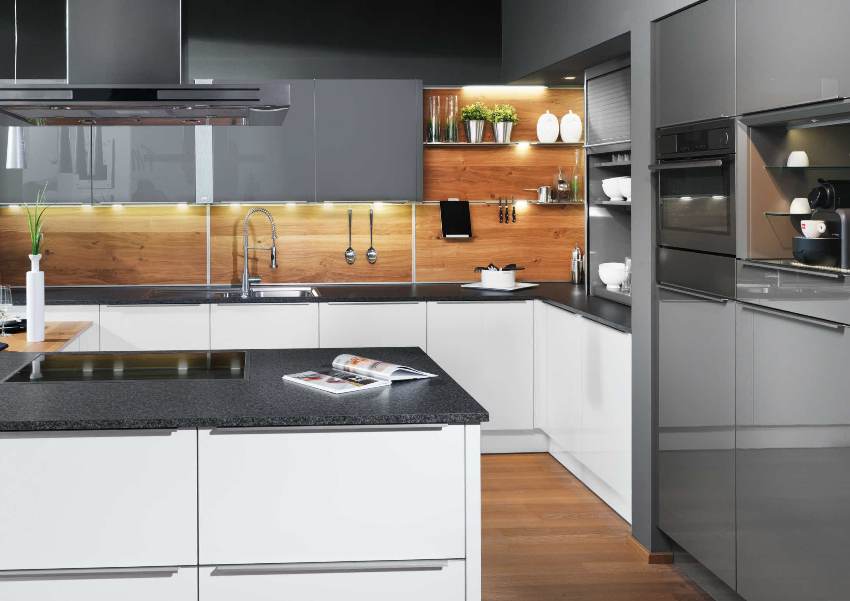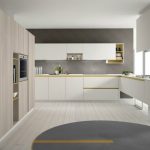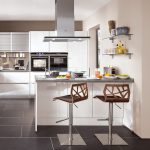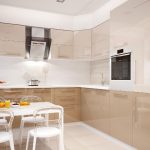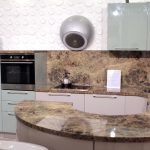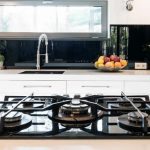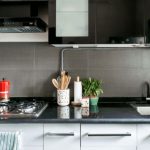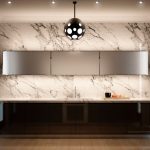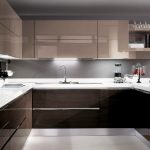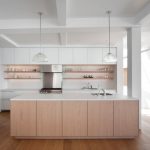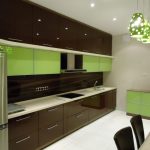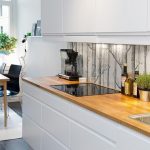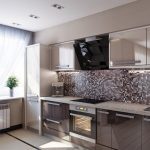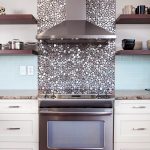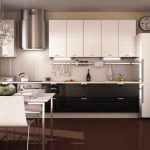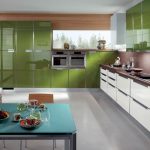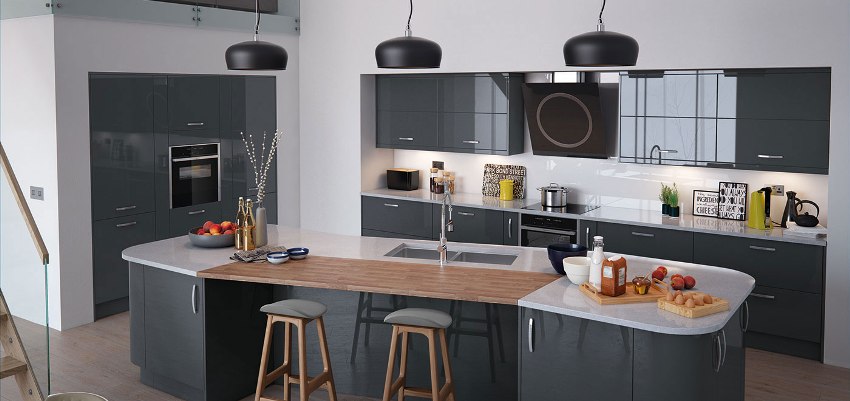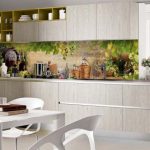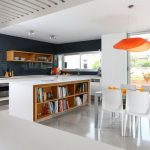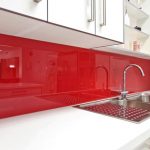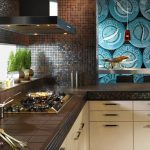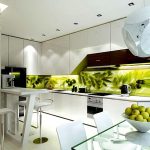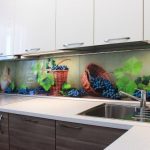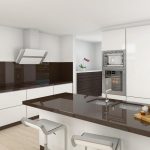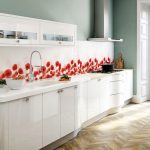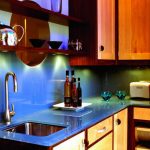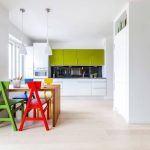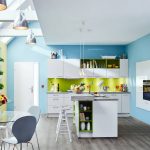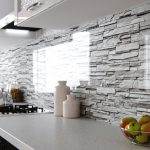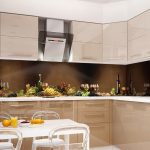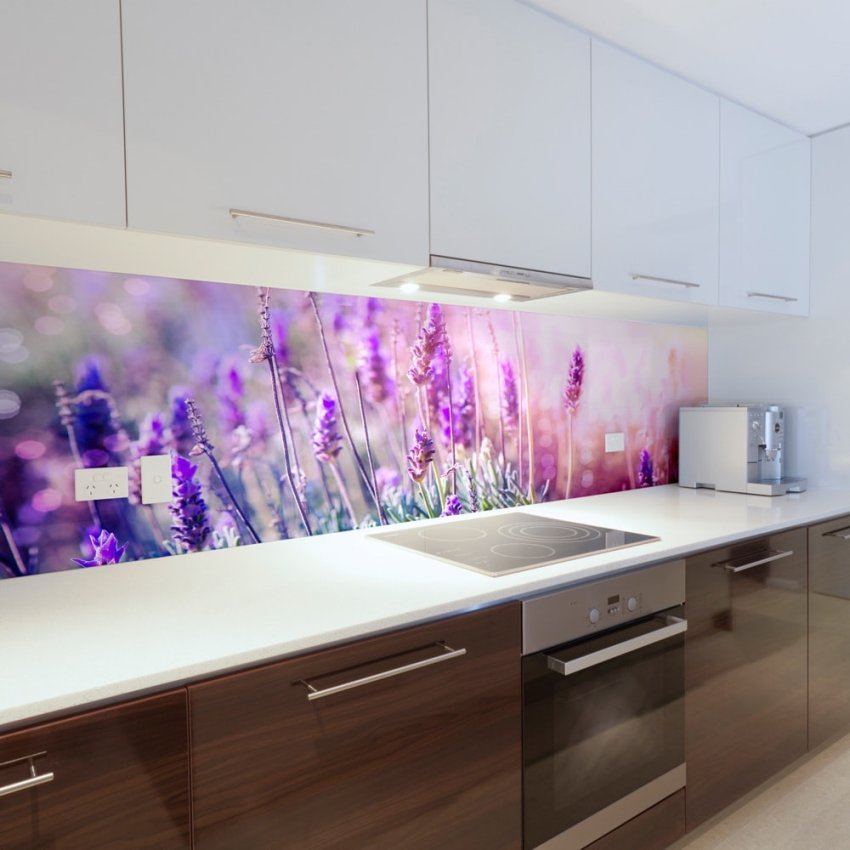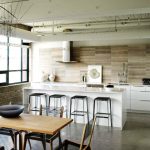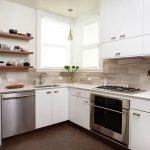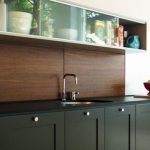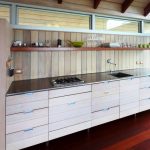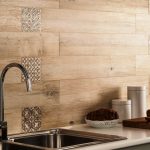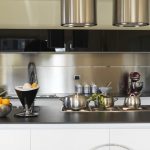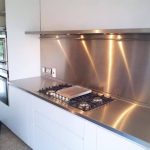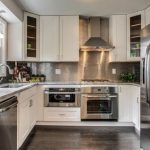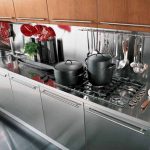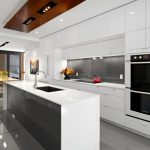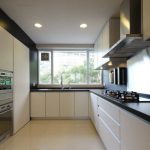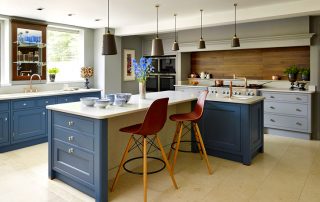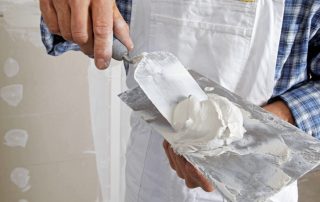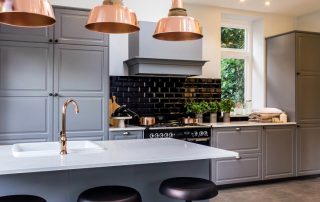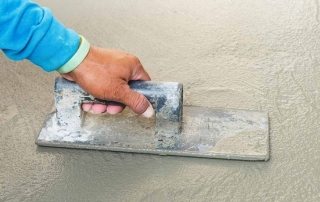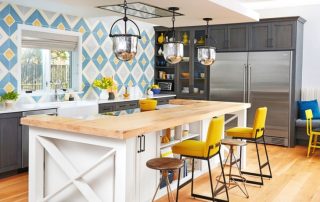An important role in the design of the kitchen is played by the space between the countertop and the wall cabinets, which is called the apron. According to tradition, it is often covered with ceramic tiles, but in the modern world new materials and methods of decoration have appeared, in particular - wall panels for the kitchen: thanks to them, an apron can acquire a different appearance. What types of material are, their features, installation and operation rules, this article will tell.
Content [Hide]
- 1 What should be a practical and beautiful kitchen apron
- 2 Types of wall panels: a variety of materials, shapes and sizes
- 3 Features of plastic wall panels for the kitchen
- 4 Wall panels for the kitchen made of MDF: characteristics and advantages
- 5 Chipboard wall panels for the kitchen: backsplash and countertop
- 6 Characteristics of glass kitchen wall panel
- 7 Kitchen panel in wood and metal: options for luxury interiors
What should be a practical and beautiful kitchen apron
The kitchen occupies an important place in an apartment or house, since almost all household members spend a lot of time here. Therefore, the design of this room should be approached with special responsibility. An important element in creating a beautiful and practical decor is an apron - this is a part of the wall in the working area that is subject to various tests in the form of dirt, temperature and humidity changes. A properly selected protective covering for the apron will help keep the kitchen clean, and the overall interior will make it more aesthetic and comfortable.
Previously, the apron was trimmed mainly with tiles. Ceramic tiles remain in trend today, but along with it, various new materials have appeared, in particular, wall panels for the kitchen. Photos of various options can be found on the Internet and in any hardware store. Whichever material is chosen, the main thing is that it is resistant to temperature extremes, humidity, easy to clean and thus meets the following requirements:
- easy to wash and clean;
- withstood the negative and aggressive effects of abrasive detergents;
- had a high level of moisture resistance;
- distinguished by high impact resistance;
- withstood temperature drops;
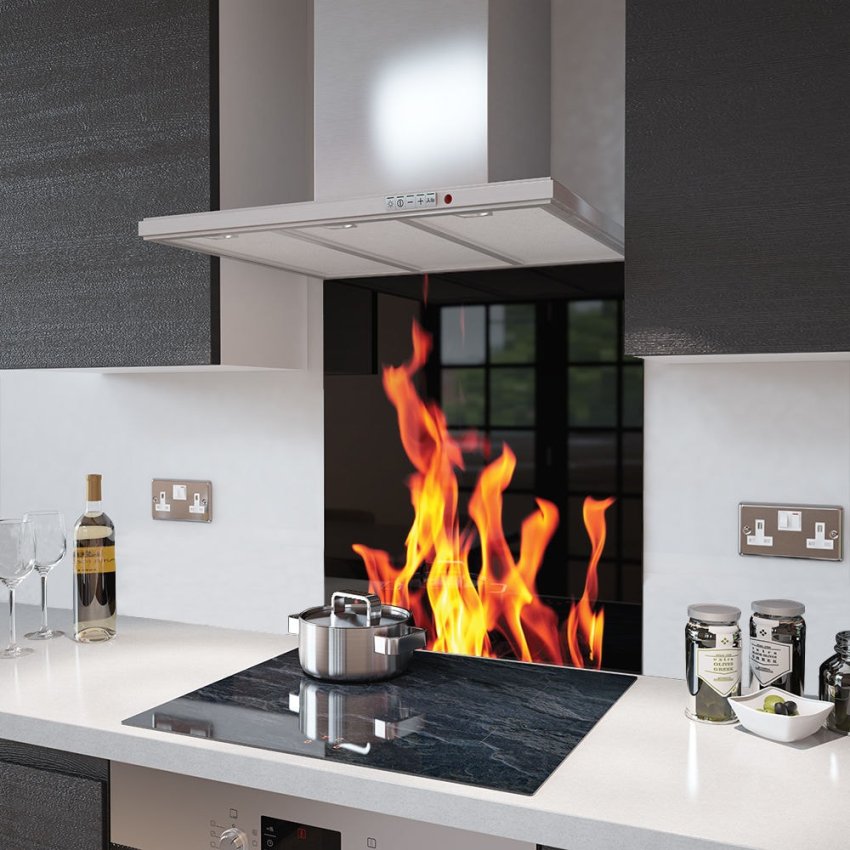
Before choosing panels for the kitchen, you need to consider several options that differ in material of manufacture and appearance.
- distinguished by its aesthetic characteristics;
- went well with the kitchen set and fit into the overall style of the kitchen.
The list of practical characteristics almost completely corresponds to the wall panels for the kitchen. Photos of aprons designed in this way clearly demonstrate the excellent aesthetic characteristics of this type of materials. Moreover, the modern market offers a wide range of products.
Wall decorative panels for an apron: features and benefits
Due to the fact that the wall panels meet all the requirements of a practical apron, this type of finish has become very popular. In addition, it has a wide range of advantages that put it in the first place in terms of practicality, economy and aesthetics.
Useful advice! Panels in the kitchen are used not only as a wall covering in the apron area. With their help, you can close uneven ceilings and walls, hide communications and other flaws.
Experts attribute the following to the main positive characteristics of wall panels:
- Ease and speed of installation. The surface does not require special preparation to accommodate the material. The process itself does not require special tools and specific practical skills.
- The multifunctionality of the material lies in the fact that they perfectly absorb sound and do not let heat through.
- Masking with panels allows you to hide wires and cables. Moreover, they do not have to be immersed in the wall and covered with plaster, which must be done when using tiles.
- Practicality of wall panels. Kitchens with such an apron do not require special care and frequent washing; special detergents are also not required.
- Profitability. Installation of panels is much cheaper than tiling or decorative painting.
- A wide range of materials allows you to choose the right option based on practical and other requirements.
- Aesthetics. Wall panels for interior decoration of the kitchen will help to make the overall design beautiful and unique.
- High thermal and moisture resistance is provided by a special coating on the panels, which repels water and does not deform under the influence of steam.
Types of wall panels: variety of materials, shapes and sizes
In the production of wall panels, a variety of materials are used, they are also distinguished by shape and size. On the construction market you can find products from:
- polyvinyl chloride or PVC;
- particle boards with a special coating of various types;
- wood fiber sheets or MDF, covered with film;
- drywall;
- laminated plywood;
- artificial stone;
- glass, which can be multi-layer, tempered, mirror, with an image or texture.
Glass panels are also called skinned. When choosing a material, it is necessary to be guided by temperature limits and not to install a material with a low level of heat resistance above the plate.
Among the panels for a kitchen apron, models of this shape are most often chosen:
- Rack, which are in the form of strips with a width of 10 to 50 cm. Usually these are inexpensive plastic panels. The slats are connected to each other thanks to special groove connectors, and are attached to the wall using a lathing.
- They look like tiles. They are produced in the form of squares or rectangles, with different side lengths. The tile for the wall panel for the kitchen acts mainly as a substitute for the ceramic counterpart.
- Sheet products are solid oblong plates. This type is considered the most common and practical. The slabs have different widths, and their length can reach three meters, thus, one sheet can cover a volumetric part of the wall of several square meters.
Plates are also distinguished by the method of fastening: they can be fixed on a crate made of simple strips of wood, metal profiles, or simply glued directly onto the wall.
Useful advice! Wall panels are a great option for novice craftsmen who independently make repairs in the kitchen. To install them, it is not necessary to remove old wallpaper or paint, ideally level the wall and hire professional craftsmen.
Features of plastic wall panels for the kitchen
Plastic plates have appeared quite a long time ago, practically since the invention of the material itself. Modern models are distinguished by increased strength, due to the updated chemical composition based on polyvinyl chloride, but at the same time they are significantly inferior to other materials due to their low strength and heat resistance.

The material from which the plastic slatted kitchen panels on the wall are made is polyvinyl chloride
The main advantage of the view is its low cost, the widest selection of products, as well as the ease of installation of the structure. Thanks to this material, you can solve a lot of tasks in the kitchen and in other rooms. The positive characteristics include their smoothness and density. PVC strips do not absorb moisture and do not let in steam, therefore they do not accumulate odors and do not contribute to the development of fungi and bacteria. The slats are easy to clean using any detergent.
The main properties of PVC boards are their lightness and flexibility. They produce wall panels for the kitchen made of plastic in different sizes. The strips can be up to 50 cm wide and up to 3 m long. They can be installed on the ceiling, walls and as an apron. An exception is the area near the oven or hob, since plastic deforms when exposed to high temperatures. In addition, plastic is easily exposed to mechanical stress, scratches remain on it, and white plates turn yellow over time.
How to choose and how to fix a wall panel for the kitchen: a plastic apron
Driven plastic products are mounted by installing on a crate of wooden planks. In this case, the distance between the fixing rails is calculated based on the weight and width of the PVC plates. If the rail is thin and soft, then the spacing between fasteners will be less. On the sides, the parts are connected using groove connectors. From above, the structure is also covered with a plastic monophonic profile.
Useful advice! To create an ideal and at the same time budget loft-style interior, you can use plastic brick panels. Material can cover not only the apron, but also one of the walls of the kitchen.
As an apron, you can choose the desired option for wall planks that have different textures and colors. Even inexpensive plastic panels in the kitchen can perfectly imitate painted boards, marble, or the rough texture of wood. In terms of texture characteristics, the slab can have both a smooth glossy and a matte surface in the form of an unhewn board, decorative plaster or stone roughness.
Related article:
Glass apron for kitchen: how to choose and install a panel
Types of glass and design methods. Methods for attaching a glass apron. The advantages and disadvantages of this solution.
The variety also applies to shades. They can be selected in accordance with the style of the room. For example, in the Provence style, slats with a textured or matte surface, imitating a painted board, will look great. Planks that imitate lacquered wood will perfectly fit into the country style. In kitchens stylized as classics, it is better to refuse PVC plates, since this direction does not tolerate artificial materials, but in modern interiors they are quite appropriate.
Wall panels for kitchen from MDF: characteristics and advantages
An excellent alternative to plastic panels can be MDF products. Their peculiarity lies in the standard size. The dimensions of the slabs from the manufacturer are: 244X60X4cm. MDF panels can be painted, laminated and veneered.
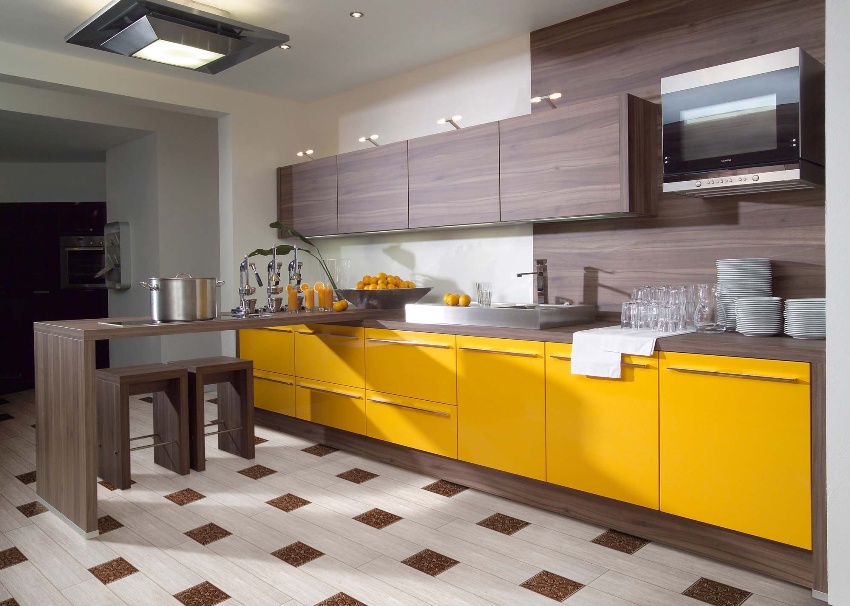
In the kitchen, MDF wall panels are most often used for finishing an apron, but often for partial or full wall cladding
Medium Density Fiberboard with the abbreviation MDF is produced by hot pressing the wood fibers. In the manufacturing process, adhesives that emit toxins are not used. The particles in the middle of the material are joined together by resins, which are released when heated. Due to this feature, MDF boards are considered harmless, therefore, they must be installed both in the working and dining areas, without fear of health.
Other advantages of MDF wall panels for the kitchen are the following characteristics:
- environmental friendliness of the material;
- low cost;
- ease of processing;
- moisture resistance;
- shock resistance;
- ease of care;
- variety of models;
- the ability to apply photo printing;
- ease of installation.
The possibility of photo printing on wood fiber boards allows you to get a beautiful and stylish interior using wall panels for the kitchen. MDF aprons are most often produced with abstract drawings, table themes and still lifes.
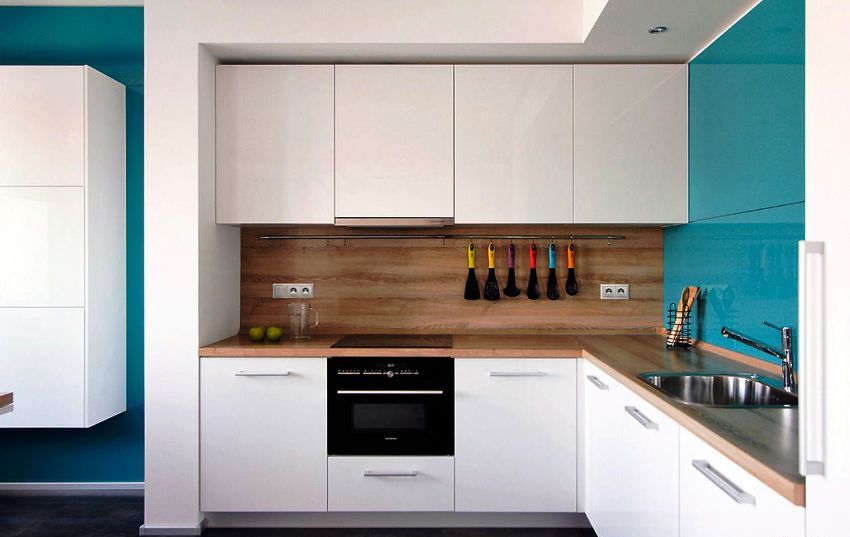
Apron for kitchen made of MDF, more often laminated and has standard sizes
There are also disadvantages of MDF panels:
- plates should not be installed above the plate, because they do not withstand high temperatures;
- the panels do not have a natural appearance;
- photo printing looks worse than on natural wood or stone.
Installation of MDF boards takes place by fastening to a special crate. This setting allows you to mask the electrical wiring or ventilation system.
Chipboard wall panels for the kitchen: backsplash and countertop
Very popular in the kitchen is material such as chipboard or chipboard. They are used as the main material for the creation of kitchen sets, countertops and wall panels. For the kitchen, it is more practical to use not classic chipboard sheets, but laminated plates - chipboard.
Conventional particle board is compressed shavings impregnated with acrylic adhesive coated with paper or thin film. The paper surface quickly deforms and swells from moisture and steam. For laminated models, the top layer, imitating wood or stone, consists of a transparent polymer layer, which serves as an excellent protection for the paper covering, prevents it from getting wet and resists mechanical stress.
Interesting to know! The latest invention as panels for the kitchen is HDF boards. These are MDF sheets with increased strength. They also differ in a variety of decorative coatings, but they are slightly more expensive than classical counterparts.
Thus, laminated chipboard or MDF boards have the following additional positive properties:
- moisture resistance;
- long service life;
- extensive lineup with various coverage themes;
- a wide range of sizes of wall panels for the kitchen, which allows you to choose the right option, taking into account the expected load on the surface.
The panels are cut out independently by choosing the desired shape and dimensions. The edges should be covered with special tape. It is glued under the influence of high temperature. If the incisions are not closed, they will be an excellent place for moisture to penetrate, which will lead to deformation and delamination of the material.

Advantages of chipboard products: moisture resistance, durability, a wide range of design options for the finishing layer
Wide application of laminated wall panels
The features of the laminated coating and the variety of sizes and decorative design of surfaces allow you to install canvases, both vertically and horizontally, over a certain area. Therefore, quite often they are chosen as a coating for countertops and aprons in the kitchen. Photos clearly demonstrate the harmony of such an interior. The models look the most beautiful, both of the same color and in contrasting tones. The main thing is that in such a duet the texture and texture of the material should be the same.
Installation of laminated panels, as well as models made of pure chipboard, is carried out by fastening with special hooks to a metal frame. The base must be securely fixed to the wall, since sheets of large size and thickness can be very heavy and there is a risk that they will fall from their own weight.
Laminated panels with a plastic layer of decor are especially popular now, where a polymer PVC coating serves as a substitute for a paper film. There are many options for the finishing layer. It can be both glossy and matte surfaces, both plain and textured models that imitate wood, metal, stone, leather, mosaic masonry. For example, a brick wall panel for a kitchen will be an excellent alternative to ceramic tiles.
Characteristics of glass kitchen wall panel
Glass wall panels, referred to in the construction world as skinned, have been especially popular lately. These are solid plates made of ordinary or tempered glass. Plain glass models, as a rule, are two-layer on a chipboard or film base. It should be noted that such sheets are not expensive, but at the same time they are distinguished by increased fragility. Tempered glass plates are an order of magnitude more expensive, but they are stronger and perfectly tolerate exposure to high temperatures.
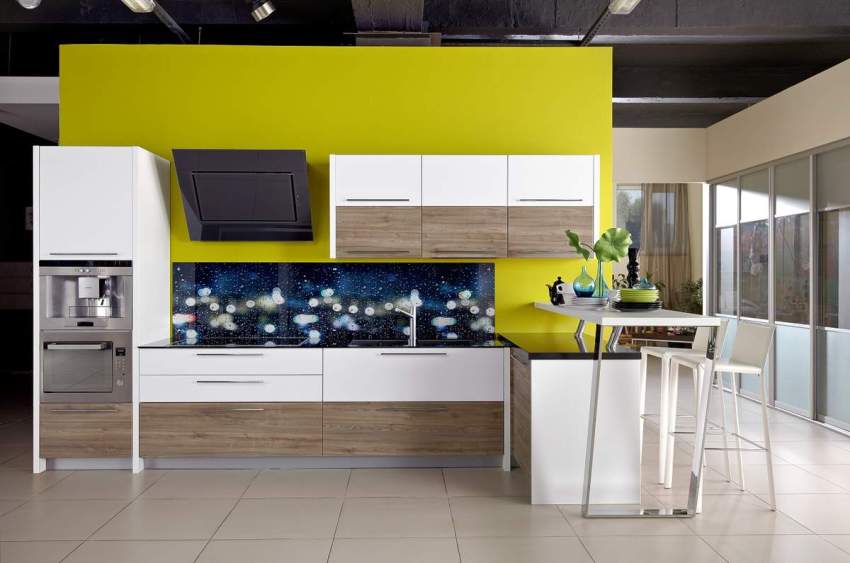
A glass panel above the stove and work surface will add luxury and uniqueness to the modern kitchen interior
Installation of skins takes place in a seamless way by attaching them to special heads. Therefore, before attaching the wall panel for the kitchen, you should prepare the base on the wall. Glass panel maintenance is quite simple due to the absence of seams. That is why such panels are made to order for specific apron sizes.
Useful advice! If the task is to create a bright and practical background on the work wall, then it is skinned with photo printing that will help to cope with it. Therefore, you should not neglect the quality and refuse this option because of the high cost of this type of finish.
Glass panels in the kitchen have a number of specific benefits:
- high operational characteristics in the form of moisture and heat resistance, allowing installation to be skipped both above the sink and above the hob;
- plates do not absorb odors, do not fade;
- ease of care and hygiene;
- uniqueness of each model and impeccable appearance.
Originality and variety of glass wall panels in the kitchen
Perhaps the main advantage of skinals is a wide range of design options. With their help, even a small and gloomy room will be instantly transformed, since correctly selected panels will help to visually expand the room and give it additional light.
Thanks to the protective layer, the glass wall panel with photo printing for the kitchen will retain its presentable appearance for a long time. Such an apron will add uniqueness, luxury to the interior of a modern kitchen, fill it with light and create a great mood.
There is a decorative layer under the heavy-duty glass coating, which can have the following base:
- painting;
- mirrors with patterns and drawings;
- matting base;
- photo printing;
- 3D image.
The most popular option in this list of panels with photo printing. For example, a glass apron with the image of juicy berries and fruits will add optimism and warmth to the room.
A monochromatic panel of milky color will perfectly fit into a white set combined with dark appliances. In a white kitchen, a photo print depicting a city at night will look great. A pure black panel will add austerity to the interior, and a bright apron will cheer you up. The image of flowers will create a spring atmosphere in the kitchen, and the seascapes will be conducive to relaxation.
Kitchen panel made of wood and metal: options for luxury interiors
Natural materials in their original form are also used as kitchen panels. For example, the cladding can be made of wood, which is used in the form of boards and slabs, which are made from an array of non-valuable technical species, and the veneer of expensive species serves as the coating.
Sheets of this type can be installed on a large surface, giving it solidity. The seamless effect is achieved thanks to the special connecting elements in the form of grooves and projections on the plates. Install a wooden decorative panel for the kitchen in the same way as a chipboard apron.
When giving preference to wood, it should be noted that this material is characterized by instability. For example, when exposed to hot air, wood can dry out, which will cause cracking, and when exposed to steam and water, it can swell. Therefore, natural wood cladding should not be used behind the sink and hob, in the area where the electric kettle or multicooker is located.
Useful advice! Those who cannot completely abandon luxurious wood panels should exclude their installation in the cooking area. For the sake of practicality, wood slabs can be combined with ceramic tiles or skinned behind the sink and stove.
The metal panels on the work wall will perfectly match the headset facades in the same cool silver color. This combination is appropriate in the loft and high-tech style. Installation of metal plates is carried out by installing the panels on plastic rails. Working with wood and metal requires special tools and skills, so it is better to entrust the work to experienced craftsmen so as not to spoil the expensive material.
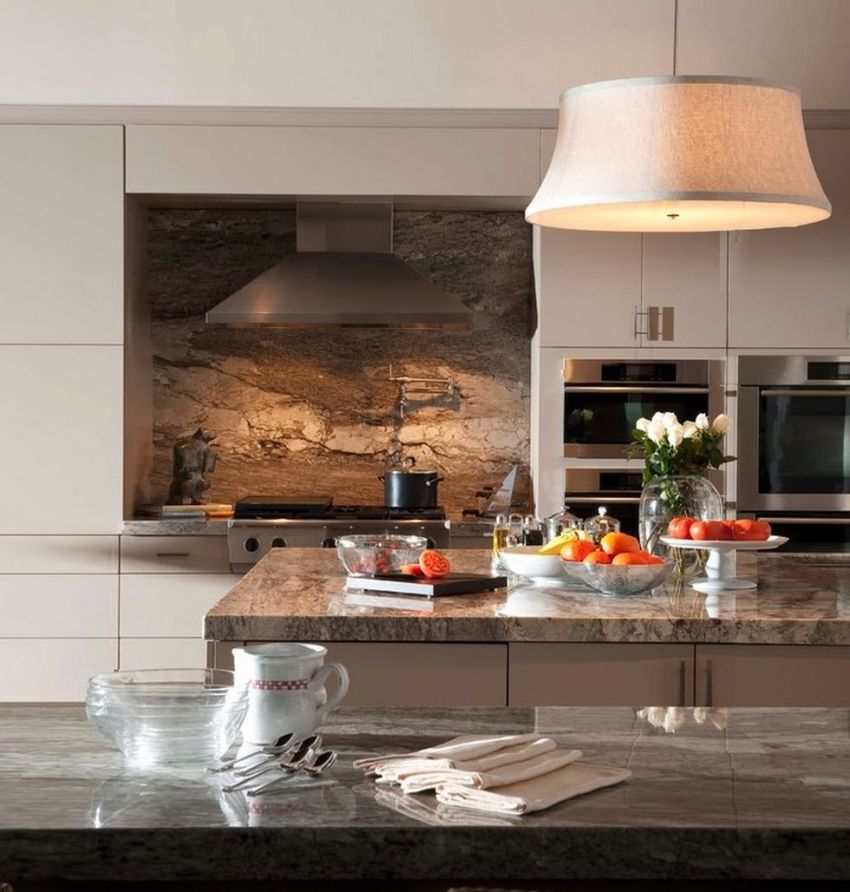
Wooden wall panels for the kitchen will create coziness in the house and will not lose their relevance over time
The best option for apron panels is skinned or laminated plates. The use of artificial stone will be justified if the necessary funds are available for their purchase and installation. Installation of plastic panels can be done by hand, in other cases it is better to attract specialists. Correctly selected and installed wall panels will help create a unique, cozy and practical interior in the kitchen.
